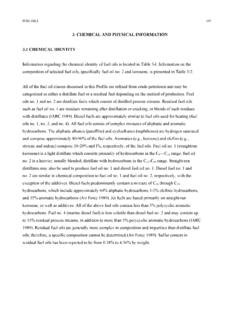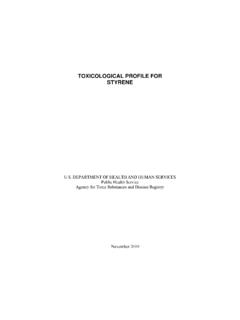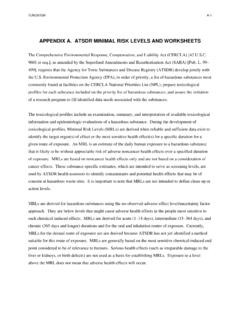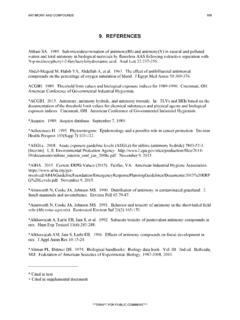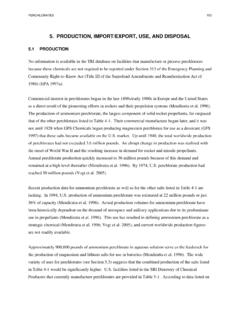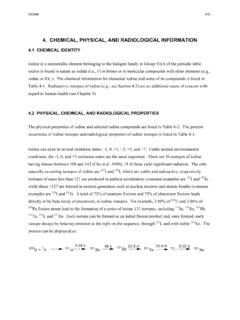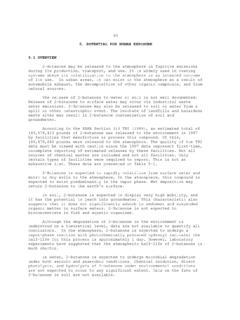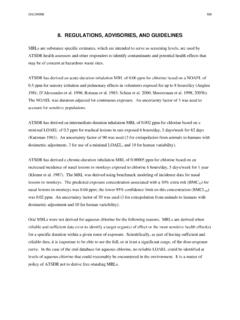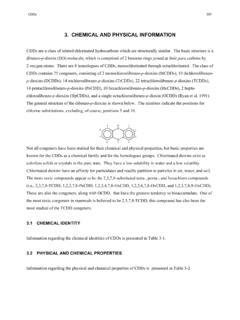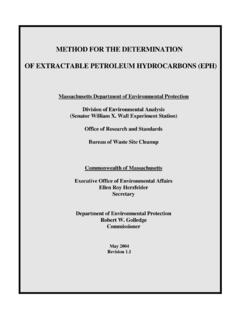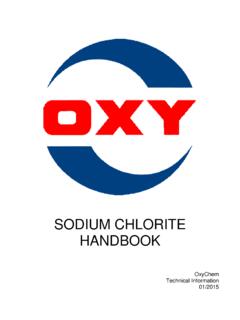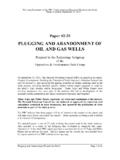Transcription of 3. IDENTITY AND ANALYSIS OF TOTAL PETROLEUM …
1 17 TOTAL PETROLEUM HYDROCARONS 3. IDENTITY AND ANALYSIS OF TOTAL PETROLEUM HYDROCARBONS INTRODUCTION PETROLEUM hydrocarbons (PHCs) are common site contaminants, but they are not generally regulated as hazardous wastes. Methods for sampling and ANALYSIS of environmental media for the family of PHCs are generally thought of as TPH methods. For purposes of this profile, the term TPH refers not only to analytical results, but also to environmental and health properties of PHCs. In part due to the complexity of TPH components themselves, little is known about their potential for health or environmental impacts. As gross measures of PETROLEUM contamination , TPH results simply show that PETROLEUM hydrocarbons are present in the sampled media. Measured TPH values suggest the relative potential for human exposure and, therefore, the relative potential for human health effects. The assessment of health effects due to TPH exposure requires much more detailed information than what is provided by a single TPH value.
2 This chapter, Chapter 5, and the accompanying Appendix E provide more detailed physical and chemical properties and analytical information on TPH and its components. The federal government has left much of the specific regulation and oversight of crude oil production/ refining to the states. Leaking underground storage tanks (LUST) are the most frequent causes of federal and state governmental involvement in PETROLEUM hydrocarbon problems. Soil contamination has been a growing concern, because it can be a source of groundwater (drinking water) contamination ; contaminated soils can reduce the usability of land for development; and weathered PETROLEUM residuals may stay bound to soils for years. Positive TPH test results may require action on the part of land owners, local or state governments, and engineering firms called on to remove or reduce the TPH problem. ATSDR has the responsibility for health assessment at National Priorities List (NPL) hazardous waste sites, many of which have PETROLEUM hydrocarbon contamination .
3 Specific contaminants that are components of TPH, such as BTEX (benzene, toluene, ethylbenzene, and xylene), n-hexane, jet fuels, fuel oils, and mineral-based crankcase oil, have been studied by ATSDR and a number of toxicological profiles have been developed on individual constituents and PETROLEUM products. The 18 TOTAL PETROLEUM HYDROCARONS 3. IDENTITY AND ANALYSIS OF TOTAL PETROLEUM HYDROCARBONS ATSDR profiles relevant to PETROLEUM products are listed in Table 3- 1. However, TPH itself has not been as extensively studied by ATSDR and no previous profile was developed. Although several toxicological profiles have been developed for PETROLEUM products and for specific chemicals found in PETROLEUM , TPH test results have been too nonspecific to be of real value in the assessment of its potential health effects. Several approaches are discussed in this document for interpreting TPH and related analytical results. The TPH approach taken by EPA and others, through the mid-1990s, followed general risk assessment approaches for chemical mixtures.
4 In all approaches there is a need to reduce a comprehensive list of potential PETROLEUM hydrocarbons to a manageable size. Depending on how conservative the approach is, methods that have been used select: (1) the most toxic among the TPH compounds (indicator approach); (2) one or more representative compounds (surrogate approach, but independent of relative mix of compounds); or (3) representative compounds for fractions of similar PETROLEUM hydrocarbons. ATSDR has taken, in part, the third approach in keeping with the TOTAL PETROLEUM Hydrocarbons Criteria Working Group (TPHCWG), but has developed its own set of TPH fraction representatives, many of which overlap those of the TPHCWG. In addition, this profile provides information on PETROLEUM products, where such information exists. TPH risk (screening) values for fractions presented in this profile are based on the ATSDR MRLs previously developed for individual constituents and PETROLEUM products.
5 These MRLs are summarized in Appendix A. This fraction approach is the most demanding in information gathering and because of that would appear to be the most rigorous approach to date. Sections and contain a more comprehensive discussion of the approaches. The IDENTITY , chemical-physical, and analytical information discussed and listed in this chapter, in Appendices D and E, and in Chapter 5 are integral to defining TPH. CHEMICAL AND PHYSICAL INFORMATION PETROLEUM products are complex mixtures of hundreds of hydrocarbon compounds, ranging from light, volatile, short-chained organic compounds to heavy, long-chained, branched compounds. The exact composition of PETROLEUM products varies depending upon (1) the source of the crude oil (crude oil is derived from underground reservoirs which vary greatly in their chemical composition) and (2) the refining practices used to produce the product. 20 TOTAL PETROLEUM HYDROCARONS 3. IDENTITY AND ANALYSIS OF TOTAL PETROLEUM HYDROCARBONS During the refining process, crude oil is separated into fractions having similar boiling points.
6 These fractions are then modified by cracking, condensation, polymerization, and alkylation processes, and are formulated into commercial products such as naphtha, gasoline, jet fuel, and fuel oils. The composition of any one of these products can vary based on the refinery involved, time of year, variation in additives or modifiers, and other factors. The chemical composition of the product can be further affected by weathering and/or biological modification upon release to the environment. The following subsections present overviews of PETROLEUM products. Also, a master list of individual aliphatic and aromatic compounds found in TPH is provided in Appendix D. Further information on whole PETROLEUM products, their IDENTITY , major components, and physical/chemical properties is found in Appendix E. Automotive Gasoline. Automotive gasoline is a mixture of low-boiling hydrocarbon compounds suitable for use in spark-ignited internal combustion engines and having an octane rating of at least 60.
7 Additives that have been used in gasoline include alkyl tertiary butyl ethers ( MTBE), ethanol (ethyl alcohol), methanol (methyl alcohol), tetramethyl-lead, tetraethyl-lead, ethylene dichloride, and ethylene dibromide. Other categories of compounds that may be added to gasoline include anti-knock agents, antioxidants, metal deactivators, lead scavengers, anti-rust agents, anti-icing agents, upper-cylinder lubricants, detergents, and dyes (ATSDR 1995a). Automotive gasoline typically contains about 150 hydrocarbon compounds, though nearly 1,000 have been identified (ATSDR 1995a). The relative concentrations of the compounds vary considerably depending on the source of crude oil, refinery process, and product specifications. Typical hydrocarbon chain lengths range from C4 through Cl2 with a general hydrocarbon distribution consisting of 4-8% alkanes, 2-5% alkenes, 25-40% isoalkanes, 3-7% cycloalkanes, l-4% cycloalkenes, and 20-50% aromatics (IARC 1989a).
8 However, these proportions vary greatly. Unleaded gasolines may have higher proportions of aromatic hydrocarbons than leaded gasolines. Table (Appendix E) presents ranges and weight percentage means for a representative subset of the hydrocarbon compounds identified in gasoline. In cases where data are not available, the range and mean are left blank. TOTAL PETROLEUM HYDROCARONS 21 3. IDENTITY AND ANALYSIS OF TOTAL PETROLEUM HYDROCARBONS Stoddard Solvent. Stoddard solvent is a PETROLEUM distillate widely used as a dry cleaning solvent and as a general cleaner and degreaser. It may also be used as a paint thinner, as a solvent in some types of photocopier toners, in some types of printing inks, and in some adhesives. Stoddard solvent is considered to be a form of mineral spirits, white spirits, and naphtha; however, not all forms of mineral spirits, white spirits, and naphtha are considered to be Stoddard solvent (ATSDR 1995b). Stoddard solvent consists of 30-50% linear and branched alkanes, 30-40% cycloalkanes, and lo-20% aromatic hydrocarbons.
9 Its typical hydrocarbon chain ranges from C7 through C12 in length. Although a complete list of the individual compounds comprising Stoddard solvent is not available (Air Force 1989) some of the major components are presented in Table (Appendix E). Alcohols, glycols, and ketones are not included in the composition, as few, if any, of these types of compounds would be expected to be present in Stoddard solvent (ATSDR 1995b). Possible contaminants may include lead (<1 ppm) and sulfur ( ppm). Jet Fuel. Jet fuels are light PETROLEUM distillates that are available in several forms suitable for use in various types ofjet engines. The exact compositions of jet fuels are established by the Air Force, using specifications that yield maximum performance by the aircraft. The major jet fuels used by the military are JP-4, JP-5, JP-6, JP-7, and JP-8. Briefly, JP-4 is a wide-cut fuel developed for broad availability in times of need. JP-6 is a higher cut than JP-4 and is characterized by fewer impurities.
10 JP-5 is specially blended kerosene, and JP-7 is a high flash point special kerosene used in advanced supersonic aircraft. JP-8 is a kerosene modeled on Jet A-l fuel (used in civilian aircraft). For this profile, JP-4 will be used as the prototype jet fuel due to its broad availability and extensive use. Typical hydrocarbon chain lengths characterizing JP-4 range from C4 to C16. Aviation fuels consist primarily of straight and branched alkanes and cycloalkanes. Aromatic hydrocarbons are limited to 20-25% of the TOTAL mixture because they produce smoke when burned. A maximum of5% alkenes are allowed in JP-4 (ATSDR 1995c). The approximate distribution by chemical class is: 32% straight alkanes, 31% branched alkanes, 16% cycloalkanes, and 21% aromatic hydrocarbons (ABB Environmental 1990). The typical hydrocarbon composition of JP-4 is presented in Table (Appendix E). TOTAL PETROLEUM HYDROCARONS 22 3. IDENTITY AND ANALYSIS OF TOTAL PETROLEUM HYDROCARBONS Fuel Oil #1.
